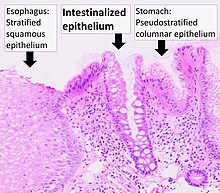| Intestinal metaplasia | |
|---|---|
 | |
| Histopathology of Barrett's esophagus, showing intestinalized epithelium with Goblet cells, as opposed to normal stratified squamous epithelium of the esophagus, and pseudostratified columnar epithelium of the fundus of the stomach. H&E stain. |
Intestinal metaplasia is the transformation (metaplasia) of epithelium (usually of the stomach or the esophagus) into a type of epithelium resembling that found in the intestine. In the esophagus, this is called Barrett's esophagus. Chronic inflammation caused by H. pylori infection in the stomach and GERD in the esophagus are seen as the primary instigators of metaplasia and subsequent adenocarcinoma formation. Initially, the transformed epithelium resembles the small intestine lining; in the later stages it resembles the lining of the colon. It is characterized by the appearance of goblet cells and expression of intestinal cell markers such as the transcription factor, CDX2.
Although H. pylori infection can cause gastrointestinal metaplasia, its eradication does not reverse the process.[1] Bile reflux is an additional pathogenic factor in gastrointestinal metaplasia that can continuously irritate the gastric mucosa. Bile acids in refluxed fluid are widely reported to be associated with gastrointesinal metaplasia.[1][2]
- ^ a b Qu X, Shi Y (July 2022). "Bile reflux and bile acids in the progression of gastric intestinal metaplasia". Chin Med J (Engl). 135 (14): 1664–1672. doi:10.1097/CM9.0000000000002290. PMC 9509189. PMID 35940882.
- ^ Bernstein H, Bernstein C, Payne CM, Dvorak K (July 2009). "Bile acids as endogenous etiologic agents in gastrointestinal cancer". World J Gastroenterol. 15 (27): 3329–40. doi:10.3748/wjg.15.3329. PMC 2712893. PMID 19610133.